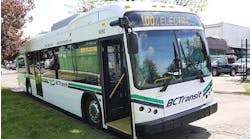OP-ED: Five predictions on how AI will revolutionize transit in 2024 and beyond
The pandemic marked a decline in ridership levels, as commuters' travel habits changed and their working schedules shifted due to safety concerns. Demand for more efficient services increased and so did expectations for seamless transit experiences that offer better customer satisfaction. Riders grew increasingly demanding when it came to flexibility, security and improved convenience during their trips. They expected shorter commute times, better accessibility, including real-time information, more multi-modal options and additional ways of paying for their journeys.
Transit providers, particularly those struggling to get ridership levels back up, will need to embrace emerging digital technologies, such as Artificial Intelligence (AI), to stay ahead of what’s become a highly competitive market. This will ensure they are equipped and adequate in delivering outstanding services, along with elevated customer experiences. It’s no longer just about investing in technology to stay relevant and go “digital” faster or save money. It’s about expanding operational capabilities, building resiliency and moving away from decades-old reliance on legacy models and systems.
Here are five predictions for how AI will revolutionize transit in 2024 and beyond:
1. AI’s analytical capabilities will revolutionize service planning and delivery
AI’s ability to process vast amounts of data, as well as draw actionable insights from it, has the potential to reframe the very paradigms of decision-making for transit agencies of all sizes. Businesses once depended on human labor to forecast trends, plan routes or gain insight into market dynamics. Sophisticated AI algorithms can now easily perform these tasks, often with unparalleled accuracy and for a mere fraction of the time.
Harnessing this intel will empower agencies to excel in service planning and delivery by pinpointing the most efficient and cost-effective routes, ensuring more accuracy in capacity planning, improving demand forecasting and enhancing overall productivity. This can save agencies valuable time, fuel and resources by assessing multiple factors, including traffic systems, weather conditions, vehicle capabilities and delivery schedules. Recent analysis provided by Report Linker predicts the global market for route optimization software will grow to be worth $21.7 billion by 2030, underlining an increase in both interest and adoption.
2. Anomaly detection will solve issues in real-time while analysis from rider feedback ensures customer satisfaction is maintained
Anomaly detection is a critical component for ensuring safety and efficiency, as well as optimal performance in transit vehicles. AI algorithms continuously monitor system health and alert operators about any unexpected events, such as changes in road conditions, maintenance and accidents. This makes it possible to react and adapt to any unfolding situations, in real-time, with little to no disruptions to services. Agencies can leverage the collected data and apply it to provide the best possible routes to their customer base along with being consistent in service provision, further aiding in retaining customer satisfaction.
AI’s role in customer feedback analysis is underlined by its ability to automate and analyze huge amounts of data with great precision and uniformity while saving time and resources for agencies. This makes it possible to analyze customer behavior patterns, their needs, preferences and expectations. Agencies will expand their customer reach by offering highly personalized user experiences, tailored product recommendations and service interventions based on actual, real-time demand.
3. AI will increase sustainability by minimizing fuel consumption in everyday operations
AI will become a powerful ally in helping agencies combat climate change by optimizing energy consumption in everyday operations. This will not only reduce costs for agencies by minimizing fuel consumption, but also help achieve a significant reduction in greenhouse gas emissions, contributing to improved air quality in cities and a greener environment. Transit providers can direct their efforts to create more efficient networks with better and more effective use of resources. Newly deployed electric vehicles in combination with cleaner, alternative fuels will further drive sustainability in the sector by promoting more eco-friendly ways to travel.
4. AI-driven analysis of customer support tickets will allow agencies to excel in delivering outstanding customer care
Harnessing the power of AI in customer services will allow agencies to take customer care interactions to the next level. By combining AI analytics with AI-infused virtual assistants, a superior level of customer service can be achieved, along with facilitating prompt responses to any issues and inquiries, further increasing customer satisfaction.
AI-driven analysis of customer support tickets will provide a deeper insight into the needs of riders, which will allow agents to improve in any area necessary to further foster loyalty and encourage adoption. Streamlining historically time-consuming tasks will free up time and resources allowing agencies to better strategize, make well-informed decisions and become more efficient in achieving accuracy and a standard that meets their rider’s needs and expectations.
5. AI predictive maintenance will equip agencies with valuable insight regarding operational efficiency and the state of their fleets
AI predictive maintenance is set to play an instrumental role in helping transit providers extend the lifespan of their assets by detecting anomalies in their fleets early on, reducing the need for costly repairs. AI algorithms will analyze historical and real-time data collected from sensors installed in vehicles, predicting their maintenance needs while reducing the chances of breakdowns during services. This proactive approach will allow agencies to identify potential issues before they occur or escalate into major problems and for any repairs to be scheduled for off-peak times, reducing downtime and ensuring services are running uninterrupted.
Conclusion
By investing in AI, in combination with cyber security and cloud technologies, agencies can truly elevate the human experience by radically transforming service delivery and back-office operations. This will not only modernize systems and service offerings, but also increase rider behavior predictability to help agencies manage their operations better, optimizing routes, allocating resources wherever needed and minimizing costs. Moving in this direction will foster innovation and sustainability in the sector, along with making transit more attractive and accessible to all members of the public.

Miroslav Katsarov | CEO, Modeshift
Miroslav Katsarov is the CEO of Modeshift. His expertise and background include business strategy, business planning, telecommunications, managing system integrations, security and automation business units.


